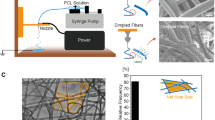Abstract
When the porous biomaterials are used to implant in vivo of animal for repairing wound, the angiogenesis in microenvironment of porous biomaterial is a key process in order to achieve the goal of treatment. While clarifying the process of vascularization and its mechanism is of great significance for design and development of medical biomaterials. In this area, it is noted that the endothelial tubes of new capillaries are formed by intracellular vacuoles, which has been proved in vitro model of angiogenesis. However, there is still no conclusive evidence in vivo model for mammals. By experimental tracking and observation of angiogenesis in the biomaterials implanted in rats, the angiogenesis process and the characteristics were explored. This study focused on the behavior of endothelial cell (EC)s and the capillary lumen formatting from EC cord in sprouting. Through marking and observing the ECs, the experimental evidences of angiogenesis after implanted materials into rats were obtained, which including various stages, such as rapidly proliferating of ECs, assembling of ECs to build up cell cord and vacuoles formation in ECs. An important mechanism of lumen formation for mammal in vivo was proved, which complemented the experimental results of the assembly of endothelial tubes in vivo through the formation and fusion of vacuoles for transgenic zebrafish. Our results provide support for the model of lumen formation of new capillary in mammal.







Similar content being viewed by others
References
Shweiki D, Iti A, Soffer D, Keshet E. Vascular enothelial growth factor induced by hypoxia may mediate hypoxia-initiated angiogenesis. Nature. 1992;359:843–5.
Bai L, Jianmei X, Qilong S, Chuanxia D. On the growth model of the capillaries in the porous silk fibroin films. J Mater Sci Mater Med. 2007;18:1917–21.
Bai L, Wu D, et al. On modes of angiogenesis and the mechanism in porous silk fibroin films. J Mater Sci Mater Med. 2011;22:927–33.
Lun B, Jianmei X, et al. Emerging models of angiogenesis patterns and response effect of endothelial cells. Fiber Bioeng Inform. 2009;2(3):150–7.
Minoura N, Tsukada M, Nagura M. Physico-chemical properties of silk fibroin membrane as a biomaterial. Biomaterials. 1990;11:430–4.
Minoura N, Aiba S, Gotoh Y, Tsukada M, Imai Y. Attachment and growth of cultured fibroblast cells on silk protein matrices. J Biomed Mater Res. 1995;29:1215–21.
Gotoh Y, Tsukada M, Minoura N. Effect of the chemical modification of the arginyl residue in Bombyx mori silk fibroin on the attachment and growth of fibroblast cells. J Biomed Mater Res. 1998;39:351–7.
Inouye K, Kurokawa M, Nishikawa S, Tsukada M. Use of Bombyx mori silk fibroin as a substratum for cultivation of animal cells. J Biochem Biophys Methods. 1998;37(3):159–64.
Li M, Lu S, Wu Z, et al. Study on porous silk fibroin materials. I. fine structure of freeze dried silk fibroin. J Appl Polym Sci. 2001;79:2185–91.
Li M, Wu Z, Zhang C, et al. Study on porous silk fibroin materials. II. Preparation and characteristics of spongy porous silk fibroin materials. J Appl Polym Sci. 2001;79:2192–9.
Downs KM. Florence Sabin and the mechanism of blood vessel lumenization during vasculogenesis. Microcirculation. 2003;10:5–25.
Folkman J, Haudenschild C. Angiogenesis by capillary endothelial cells in culture. Trans Ophthalmol Soc UK. 1980;100:346–53.
Folkman J, Haudenschild C. Angiogenesis in vitro. Nature. 1980;288:551–6.
Kamei M, Saunders WB, Bayless KJ, Dye L, Davis GE, Weinstein BM. Endothelial tubes assemble from intracellular vacuoles in vivo. Nature. 2006;442:453–6.
Li M, Ogiso M, Minoura N. Enzymatic degradation behavior of porous silk fibroin sheets. Biomaterials. 2003;24:357–65.
Acker T, Plate KH. Role of hypoxia in tumor angiogenesis-molecular and cellular angiogenic crosstalk. Cell Tissue Res. 2003;314:145–55.
Semenza GR. Hypoxia-inducible factor 1: master regulator of O2 homeostasis. Curr Opin Genet Dev. 1998;8:588–94.
Bennett NT, Schultz GS. Growth factors and wound healing: part II. Role in normal and chronic annual conference N8, Prouts Neck ME, ETATS-UNIS. 1993;165(6):741–750.
Shweiki D, Itin A, Soffer D, Keshet E. Vascular endothelial growth factor induced by hypoxia may mediate hypoxia-initiated angiogenesis. Nature. 1992;359(6398):843–5.
Altankov G, Groth T, Engel E, et al. Development of provisional extracellular matrix on biomaterials interface: lessons from in vitro cell culture, advances in regenerative medicine: NATO science for peace and security series A: chemistry and biology. 2010;19–43.
Kremer C, Breier G, Risau W, et al. Up-regulation of flk-1/vascular endothelial growth factor receptor 2 by its ligand in a cerebral slice culture system. Cance Res. 1997;57:3852–9.
Plate KH, Breier G, Weich HA, Risau W. Vascular endothelial growth factor is a potential tumour angiogenesis factor in human gliomas in vivo. Nature. 1992;359(6398):845–8.
Liu Y. Microcirculation map, People’s military medical press; 2005. p. 182.
Acknowledgments
We are grateful to Zhiling Sun, Dongoing Wu, Yongzhen Chen, Zhenyu Wu for their excellent assistance.
Author information
Authors and Affiliations
Corresponding author
Rights and permissions
About this article
Cite this article
Bai, L., Zhan, K., Hu, Q. et al. Endothelial tubes form from intracellular vacuoles in implanted biomaterial in vivo of rat. J Mater Sci: Mater Med 25, 1275–1282 (2014). https://doi.org/10.1007/s10856-014-5148-x
Received:
Accepted:
Published:
Issue Date:
DOI: https://doi.org/10.1007/s10856-014-5148-x




